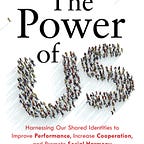How to think beyond your own mind.
We are excited to host an interview about ‘The Extended Mind: The Power of Thinking Outside the Brain’, by Annie Murphy Paul. There are countless think pieces, apps and coaches offering advice on how to maximize your own cognitive abilities. But beyond a certain limit, it becomes harder to get any more effective without working ourselves to death.
This is where “The Extended Mind” comes in. The book explains how a great deal of human thinking takes place outside the individual mind. People are able to exploit external resources to think, “including the feelings and movements of our bodies; the physical spaces in which we learn and work; and the other minds with which we interact — our classmates, colleagues, teachers, supervisors, friends”.
Cognitive sciences have long described the mind as a single, lonely computer. But a better metaphor for the mind is the internet. We are connected to numerous other people through social networks and this allows us to harness a far greater cognitive capacity than our puny individual minds would normally allow. Annie explains how we can optimize this potential. She argues “people who need to think together should learn and train together; they should feel together (that is, have shared emotional experiences); and they should engage in rituals together”.
If this sounds interesting or useful to you, we encourage you to read the rest of the interview and check out her book. Annie generously agreed to answer a few questions about how group dynamics can be harnessed for better decision making:
What does your book teach us about group dynamics?
The Extended Mind explores the notion that we don’t think just with our own brains — we “think with” the minds of other people (and with other outside-the-head resources, like our bodies and our technological devices). The book argues that it’s possible to generate a “group mind,” a collective entity that is more intelligent than any one of its members — but that in order to do so, we have to adopt new attitudes and practice new habits. In our hyper-individualistic society, we’re accustomed to paying attention, recalling information, solving problems, and generating motivation as individuals. The strategies we apply when thinking as solitary people don’t work very well when we’re thinking as part of a group. And yet “distributed cognition,” or shared mental labor, is increasingly required to meet the challenges of our complex, dynamic world. The book contends that this reality means we’re all in need of a second education. We’ve learned how to think with our brains; now we need to learn how to think outside the brain.
What was the most surprising thing you learned about shared cognition?
The most surprising thing I learned about shared cognition concerned the sheer variety of mechanisms that human beings have evolved to “get on the same page.” I loved learning about shared attention and the way it begins with very young infants following the gaze of their parents and caregivers. I was amazed to discover how viscerally the experience of synchronous movement — moving in time with other people — bonds us to one another. And I was inspired by the phenomenon of shared motivation: the finding that people become more motivated to perform well when their efforts are being made on behalf of a meaningful group to which they belong. We think of ourselves as individuals, but we’ve developed so many ways to bridge the gap between ourselves and others.
What is the biggest unanswered question in this area going forward?
I would say that the biggest unanswered question — about which I’m very keen to know the answers! — is what happens in the brain when people think together, as compared to when they think alone. What has been called by some researchers “two-person neuroscience,” and by other researchers “the interactive brain hypothesis,” is just getting underway, and I anticipate that this work will generate many fascinating findings about how social interaction affects cognition.
Do you have any practical advice for people who want to apply these ideas?
Psychologists have determined that groups differ widely on what they call “entitativity” — or, in a catchier formulation, their “groupiness.” The key to generating groupiness lies in creating a certain kind of group experience: real-time encounters, in which people act and feel together in close physical proximity. In practical terms, that means that people who need to think together should learn and train together; they should feel together (that is, have shared emotional experiences); and they should engage in rituals together (that is, engage in meaningful acts, even one so common as sharing a meal). All these encounters ought to be happening in person, at the same time. Unfortunately, our schools and companies are increasingly taking the opposite tack: aided by technology, they are creating individual, asynchronous, atomized experiences for students and employees. It’s my hope that, as the pandemic recedes, we will appreciate anew the unmatched power of bringing people together in time and space.
To learn more about The Extended Mind: www.anniemurphypaul.com
If you want to get smarter about groups and help build smarter groups, join our free weekly newsletter on “The Power of Us”.
More interviews with book authors
We plan to host regular interviews with authors of books related to social identity, group dynamics, and collective behavior. If you have a new book on the topic that would interest our readers, fill out this form.
